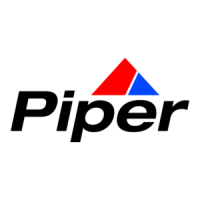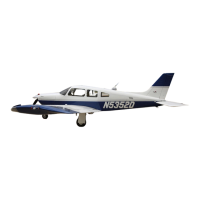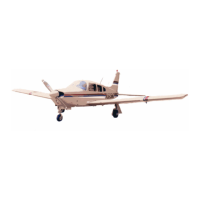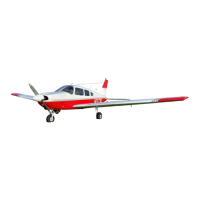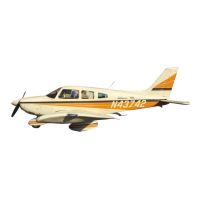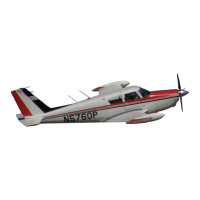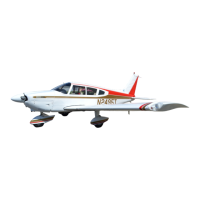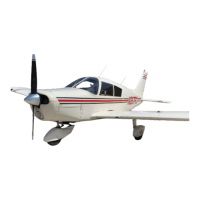Do you have a question about the Piper Arrow PA-28R-201 and is the answer not in the manual?
Provides details on revisions made to the handbook, including identification of changed material.
Explains the purpose and scope of the handbook as an operating guide.
Details the specifications of the aircraft's engine, including manufacturer, model, horsepower, and type.
Provides specifications for the installed propellers, including manufacturer, blade model, and diameter.
Lists fuel capacity, usable fuel, grade, and approved alternate fuels for the aircraft.
Details the maximum takeoff, landing, and baggage compartment weights for the aircraft.
Provides standard empty weight and maximum useful load values for the airplane.
Defines symbols, abbreviations, and terminology used throughout the handbook for clarity.
Outlines FAA approved operating limitations, instrument markings, and placards for safe operation.
Lists critical airspeeds such as Never Exceed Speed (VNE), Maximum Structural Cruising Speed (VNO), and Maneuvering Speed (VA).
Details the color-coded markings on the airspeed indicator (IAS) for different operational ranges.
Specifies limits for the engine and propeller, including operating limits, blade angle limits, and RPM restrictions.
States the maximum takeoff, landing, and baggage compartment weights for the aircraft.
Provides forward and rearward CG limits based on weight, with notes on straight-line variation.
Prohibits acrobatic maneuvers including spins and lists approved maneuvers within bank and pitch limits.
Specifies the maximum positive and negative load factors allowed for the aircraft during flight.
Details total fuel capacity, unusable fuel, usable fuel, and warnings about fuel indicators reading zero.
Lists placards required to be in full view of the pilot, covering flight limitations, fuel, and operational warnings.
Provides recommended procedures for coping with various emergency or critical situations as required by the FAA.
Lists critical airspeeds for safe operation, including stall speeds, maneuvering speeds, and power-off glide speed.
Supplies a short-form checklist for immediate action sequences during critical situations.
Outlines immediate actions for an engine fire during start, including mixture, throttle, and fuel selector settings.
Details actions for engine power loss during takeoff, including landing gear and restart procedures.
Provides procedures for engine power loss in flight, differentiating between low altitude and higher altitude scenarios.
Outlines steps for a power-off landing, including trim, field selection, and gear configuration.
Details immediate actions for electrical or engine fires in flight, emphasizing landing as soon as possible.
Describes actions for loss of oil pressure, recommending landing as soon as possible to investigate.
Outlines procedures for alternator failure, including reducing electrical load and resetting the overvoltage relay.
Provides procedures for extending landing gear in an emergency, including pre-extension checks and manual release steps.
Details steps for recovering from an unintentionally entered spin, emphasizing rudder and control wheel inputs.
Provides normal operating procedures for the aircraft and outlines the section's structure of checklists and amplified procedures.
Lists significant airspeeds for safe operation, including best rate/angle of climb, turbulent air speed, and flap speeds.
Presents a checklist for normal flight operations, encompassing preflight, engine start, taxiing, and takeoff.
Details the preflight inspection steps for the cockpit, right wing, nose section, left wing, and fuselage.
Lists checks to be performed before starting the engine, including brakes, circuit breakers, and fuel selector.
Provides procedures for starting the engine, covering cold, hot, flooded, and external power start scenarios.
Details takeoff techniques, including normal, short field, obstacle clearance, and soft field procedures.
Outlines procedures for approach and landing, including fuel selector, seat belts, flaps, and air conditioner settings.
Describes stall characteristics and indications, including stall warning horn activation and speeds.
Details the landing gear system, including indicators, warning lights, and extension procedures.
Provides required FAA regulations and complementary performance information for the aircraft.
Explains that performance information is based on measured Flight Test Data corrected to standard conditions.
Outlines a detailed flight plan using performance charts, including aircraft loading and takeoff/landing considerations.
Lists figures and graphs related to aircraft performance, such as air temperatures, airspeed calibration, and takeoff/landing distances.
Explains the importance of flying within the approved weight and CG envelope for performance and characteristics.
Details the procedure for determining basic empty weight and CG location, including preparation and weighing steps.
Refers to forms for basic empty weight, CG location, and useful load, and the importance of the weight and balance record.
Guides on calculating total weight and moment to determine CG location and ensure it's within the approved envelope.
Provides a general overview of the aircraft, including engine type, seating capacity, and horsepower.
Describes the airframe construction, including fuselage, wings, spars, flaps, and fuel tanks.
Details the engine specifications, propeller type, and associated controls like mixture and throttle.
Explains the induction system, including the Bendix RSA-5AD1 fuel injector and alternate air source.
Describes the throttle, propeller, and mixture controls, their location, and associated safety features.
Details the retractable tricycle landing gear system, its hydraulic actuation, and indicator lights.
Explains the dual flight controls, cable system, trim tab function, and rudder system.
Describes the fuel system, including tank capacity, usable fuel, minimum grade, and venting.
Details the electrical system components, including switch panels, circuit breakers, and standard/optional accessories.
Describes the pitot and static system for airspeed, altimeter, and vertical speed indicators, including optional heated pitot.
Provides a diagram and identification of instruments on the pilot's panel.
Details cabin features such as seat adjustments, armrests, rear seat removal, and seat belt/shoulder harness.
Describes the stall warning horn activation and its relation to stall speeds and airframe buffeting.
Describes the optional starting system using an external power source via a fuselage receptacle.
Explains the operation and maintenance of the ELT, including battery replacement and test procedures.
Provides guidelines for handling, servicing, and maintenance, referencing the specific maintenance manual.
Outlines inspection intervals and requirements based on PIPER-approved parts and FAA regulations.
Details preventive maintenance tasks that a pilot with a Pilot Certificate may perform according to FAR Part 43.
Explains the requirement for FAA approval for aircraft modifications and lists required aircraft papers.
Provides guidelines for ground handling, including towing, taxiing, and parking procedures.
Details the procedure for removing, cleaning, and installing the engine air filter.
Explains the brake system, including fluid type, reservoir location, and the need for replacement when worn.
Covers servicing of landing gear oleo struts and steering adjustments, including jacking procedures.
Advises on cleaning and inspecting the propeller, spinner, and backing plate for cracks and nicks.
Specifies the engine oil capacity, minimum safe quantity, and recommended oil grades based on ambient temperature.
Details fuel system servicing, including fuel grade requirements and filling/draining procedures.
Provides recommended tire inflation pressures for nose and main tires and emphasizes wheel balancing.
Explains battery location, fluid level checks, charging recommendations, and external power receptacle.
Provides procedures for cleaning the engine compartment, landing gear, and exterior surfaces, with cautions for solvent use.
Provides operational information for the optional Piper Auxiliary Vacuum System.
Outlines operational information for the Bendix/King 100 Series Flight Control System, noting manufacturer responsibility for revisions.
Provides operational information for the KLN 89B GPS system, detailing its capabilities and limitations.
Details the operation of the KX 155A Comm/Nav system, including transceiver and receiver functions.
Details the operation of the Garmin GTX 330 Transponder, including mode selection and configuration.
Details the operation of the S-TEC DME-450 system, including its features and controls.
Provides operational information for the S-TEC System 55 Autopilot, including limitations and emergency procedures.
Provides general descriptions of the PFD and MFD systems and their operation.
Details the operation of the Garmin GTX 330 Transponder, including mode selection and configuration.
Explains the operation of the Bendix/King KR-87 Digital ADF and KI-227 Indicator, including modes and controls.
Details the operation of the Bendix/King KN-63 DME system, including its components and controls.
Provides operational information for the Garmin GNS 430W system, covering general, limitations, and emergency procedures.
Provides details on revisions made to the handbook, including identification of changed material.
Explains the purpose and scope of the handbook as an operating guide.
Details the specifications of the aircraft's engine, including manufacturer, model, horsepower, and type.
Provides specifications for the installed propellers, including manufacturer, blade model, and diameter.
Lists fuel capacity, usable fuel, grade, and approved alternate fuels for the aircraft.
Details the maximum takeoff, landing, and baggage compartment weights for the aircraft.
Provides standard empty weight and maximum useful load values for the airplane.
Defines symbols, abbreviations, and terminology used throughout the handbook for clarity.
Outlines FAA approved operating limitations, instrument markings, and placards for safe operation.
Lists critical airspeeds such as Never Exceed Speed (VNE), Maximum Structural Cruising Speed (VNO), and Maneuvering Speed (VA).
Details the color-coded markings on the airspeed indicator (IAS) for different operational ranges.
Specifies limits for the engine and propeller, including operating limits, blade angle limits, and RPM restrictions.
States the maximum takeoff, landing, and baggage compartment weights for the aircraft.
Provides forward and rearward CG limits based on weight, with notes on straight-line variation.
Prohibits acrobatic maneuvers including spins and lists approved maneuvers within bank and pitch limits.
Specifies the maximum positive and negative load factors allowed for the aircraft during flight.
Details total fuel capacity, unusable fuel, usable fuel, and warnings about fuel indicators reading zero.
Lists placards required to be in full view of the pilot, covering flight limitations, fuel, and operational warnings.
Provides recommended procedures for coping with various emergency or critical situations as required by the FAA.
Lists critical airspeeds for safe operation, including stall speeds, maneuvering speeds, and power-off glide speed.
Supplies a short-form checklist for immediate action sequences during critical situations.
Outlines immediate actions for an engine fire during start, including mixture, throttle, and fuel selector settings.
Details actions for engine power loss during takeoff, including landing gear and restart procedures.
Provides procedures for engine power loss in flight, differentiating between low altitude and higher altitude scenarios.
Outlines steps for a power-off landing, including trim, field selection, and gear configuration.
Details immediate actions for electrical or engine fires in flight, emphasizing landing as soon as possible.
Describes actions for loss of oil pressure, recommending landing as soon as possible to investigate.
Outlines procedures for alternator failure, including reducing electrical load and resetting the overvoltage relay.
Provides procedures for extending landing gear in an emergency, including pre-extension checks and manual release steps.
Details steps for recovering from an unintentionally entered spin, emphasizing rudder and control wheel inputs.
Provides normal operating procedures for the aircraft and outlines the section's structure of checklists and amplified procedures.
Lists significant airspeeds for safe operation, including best rate/angle of climb, turbulent air speed, and flap speeds.
Presents a checklist for normal flight operations, encompassing preflight, engine start, taxiing, and takeoff.
Details the preflight inspection steps for the cockpit, right wing, nose section, left wing, and fuselage.
Lists checks to be performed before starting the engine, including brakes, circuit breakers, and fuel selector.
Provides procedures for starting the engine, covering cold, hot, flooded, and external power start scenarios.
Details takeoff techniques, including normal, short field, obstacle clearance, and soft field procedures.
Outlines procedures for approach and landing, including fuel selector, seat belts, flaps, and air conditioner settings.
Describes stall characteristics and indications, including stall warning horn activation and speeds.
Details the landing gear system, including indicators, warning lights, and extension procedures.
Provides required FAA regulations and complementary performance information for the aircraft.
Explains that performance information is based on measured Flight Test Data corrected to standard conditions.
Outlines a detailed flight plan using performance charts, including aircraft loading and takeoff/landing considerations.
Lists figures and graphs related to aircraft performance, such as air temperatures, airspeed calibration, and takeoff/landing distances.
Explains the importance of flying within the approved weight and CG envelope for performance and characteristics.
Details the procedure for determining basic empty weight and CG location, including preparation and weighing steps.
Refers to forms for basic empty weight, CG location, and useful load, and the importance of the weight and balance record.
Guides on calculating total weight and moment to determine CG location and ensure it's within the approved envelope.
Provides a general overview of the aircraft, including engine type, seating capacity, and horsepower.
Describes the airframe construction, including fuselage, wings, spars, flaps, and fuel tanks.
Details the engine specifications, propeller type, and associated controls like mixture and throttle.
Explains the induction system, including the Bendix RSA-5AD1 fuel injector and alternate air source.
Describes the throttle, propeller, and mixture controls, their location, and associated safety features.
Details the retractable tricycle landing gear system, its hydraulic actuation, and indicator lights.
Explains the dual flight controls, cable system, trim tab function, and rudder system.
Describes the fuel system, including tank capacity, usable fuel, minimum grade, and venting.
Details the electrical system components, including switch panels, circuit breakers, and standard/optional accessories.
Describes the pitot and static system for airspeed, altimeter, and vertical speed indicators, including optional heated pitot.
Provides a diagram and identification of instruments on the pilot's panel.
Details cabin features such as seat adjustments, armrests, rear seat removal, and seat belt/shoulder harness.
Describes the stall warning horn activation and its relation to stall speeds and airframe buffeting.
Describes the optional starting system using an external power source via a fuselage receptacle.
Explains the operation and maintenance of the ELT, including battery replacement and test procedures.
Provides guidelines for handling, servicing, and maintenance, referencing the specific maintenance manual.
Outlines inspection intervals and requirements based on PIPER-approved parts and FAA regulations.
Details preventive maintenance tasks that a pilot with a Pilot Certificate may perform according to FAR Part 43.
Explains the requirement for FAA approval for aircraft modifications and lists required aircraft papers.
Provides guidelines for ground handling, including towing, taxiing, and parking procedures.
Details the procedure for removing, cleaning, and installing the engine air filter.
Explains the brake system, including fluid type, reservoir location, and the need for replacement when worn.
Covers servicing of landing gear oleo struts and steering adjustments, including jacking procedures.
Advises on cleaning and inspecting the propeller, spinner, and backing plate for cracks and nicks.
Specifies the engine oil capacity, minimum safe quantity, and recommended oil grades based on ambient temperature.
Details fuel system servicing, including fuel grade requirements and filling/draining procedures.
Provides recommended tire inflation pressures for nose and main tires and emphasizes wheel balancing.
Explains battery location, fluid level checks, charging recommendations, and external power receptacle.
Provides procedures for cleaning the engine compartment, landing gear, and exterior surfaces, with cautions for solvent use.
Provides operational information for the optional Piper Auxiliary Vacuum System.
Outlines operational information for the Bendix/King 100 Series Flight Control System, noting manufacturer responsibility for revisions.
Provides operational information for the KLN 89B GPS system, detailing its capabilities and limitations.
Details the operation of the KX 155A Comm/Nav system, including transceiver and receiver functions.
Details the operation of the Garmin GTX 330 Transponder, including mode selection and configuration.
Details the operation of the S-TEC DME-450 system, including its features and controls.
Provides operational information for the S-TEC System 55 Autopilot, including limitations and emergency procedures.
Provides general descriptions of the PFD and MFD systems and their operation.
Details the operation of the Garmin GTX 330 Transponder, including mode selection and configuration.
Explains the operation of the Bendix/King KR-87 Digital ADF and KI-227 Indicator, including modes and controls.
Details the operation of the Bendix/King KN-63 DME system, including its components and controls.
Provides operational information for the Garmin GNS 430W system, covering general, limitations, and emergency procedures.
| Manufacturer | Piper Aircraft |
|---|---|
| Model | PA-28R-201 |
| Engine | Lycoming IO-360-C1C6 |
| Horsepower | 200 hp |
| Landing Gear | Retractable Tricycle |
| Maximum Takeoff Weight | 2, 750 lbs |
| Service Ceiling | 13, 000 ft |
| Seating Capacity | 4 |
| Stall Speed | 54 knots |
| Type | Single-engine, low-wing, retractable-gear airplane |
| Propeller | Constant-speed, two-blade |
